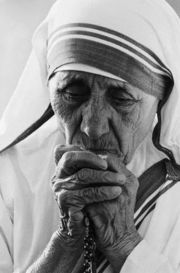
Mother Theresa is one of the most revered people in India and as a matter of fact the whole world. The following piece is not my own (Ripped it off from Wikipedia) but the reason I'm publishing is that I always wanted to listen to the lesser known side of story.
This part focuses on what the critics of Mother Theresa have to say:
Mother Teresa frequently spoke against abortion and artificial contraception in meetings with high level government officials. In her Nobel Prize acceptance speech, she declared, "Abortion is the worst evil, and the greatest enemy of peace... Because if a mother can kill her own child, what will prevent us from killing ourselves or one another? Nothing."
In the aftermath of the Bangladesh Liberation War, it was determined that more than 450,000 women in East Pakistan (now Bangladesh) had been systematically raped, giving birth to a few thousand war-babies. She asserted her rejection of abortion by publicly renouncing abortion as an option and by calling upon the women left behind to keep their unborn children. She characterized her views later when asked in 1993 about a 14-year-old rape victim in Ireland, "Abortion can never be necessary... because it is pure killing."
While this stance is in line with that of the Roman Catholic Church, which asserts natural family planning is the only acceptable form of birth control, her critics assert that Teresa dogmatically refused to acknowledge the related problems of overpopulation, especially in cities like Calcutta.[citation needed]
Teresa also campaigned tirelessly against divorce, insisting it should be made illegal; she organized an unsuccessful campaign to keep the Irish ban on divorce in 1996. However, some believe she contradicted this belief when she told the Ladies Home Journal that with respect to Prince Charles and Princess Diana, "It is a good thing that it is over. Nobody was happy anyhow.
After Indian Prime Minister Indira Gandhi's suspension of civil liberties in 1975, Mother Teresa said: "People are happier. There are more jobs. There are no strikes." These approving comments were seen as a result of the friendship between Teresa and the Congress Party. Mother Teresa's comments were even criticized outside India within Catholic media. (Chatterjee, p. 276.)
An Indian-born writer living in Britain, Dr. Aroup Chatterjee, who had briefly worked in one of Mother Teresa's homes, began investigations into the finances and other practices of Teresa's order. In November 1992, a British journalist, Christopher Hitchens, published an article in the US left-wing journal, The Nation entitled "The Ghoul of Calcutta" criticizing Mother Teresa. In 1994, Hitchens and British journalist Tariq Ali produced a critical TV documentary for the UK's Channel 4, which was entitled Hell's Angel, based on Chatterjee's work. Chatterjee has been critical of what he called the "sensationalist" approach of the film, without disputing its conclusions.
The next year, Hitchens published The Missionary Position: Mother Teresa in Theory and Practice, which repeated many of the accusations in the documentary. Chatterjee himself published The Final Verdict in 2003, a less polemic work than those of Hitchens and Ali, but equally critical of Teresa's operations.
Neither Mother Teresa nor the Vatican has ever revealed how much money her order received, nor what it was spent on; estimates range into the hundreds of millions of dollars[citation needed]. Hitchens alleged that Teresa was glad to suggest to donors that the money went to aid and the building of healthcare facilities for the poor in India and elsewhere, while evidence points instead to it being spent largely on missionary work in Africa, with large funds at Teresa's discretion. No hospitals were ever built.
Baptisms of the dying
Mother Teresa encouraged members of her order to baptize dying patients, without regard to the individual's religion. In a speech at the Scripps Clinic in California in January 1992, she said: "Something very beautiful... not one has died without receiving the special ticket for St. Peter, as we call it. We call baptism 'a ticket for St. Peter.' We ask the person, do you want a blessing by which your sins will be forgiven and you receive God? They have never refused. So 29,000 have died in that one house [in Kalighat] from the time we began in 1952."
Critics have argued that patients were not provided sufficient information to make an informed decision about whether they wanted to be baptized and the theological significance of a Catholic baptism. Since her patients were predominantly Hindus and Muslims, the baptisms would have been directly counter to their own religious beliefs; since their idea of God is vastly different from the Catholic God, the question "do you want to receive a blessing..." would be misleading without the qualifier that the God in question was the Christian God. [citation needed]
Simon Leys, one of Mother Teresa's defenders, has argued that baptisms are either soul-saving or harmless. Simon Leys, in a letter to the New York Review of Books, wrote: "Either you believe in the supernatural effect of this gesture – and then you should dearly wish for it. Or you do not believe in it, and the gesture is as innocent and well-meaningly innocuous as chasing a fly away with a wave of the hand." This view, however, does not take into account the possibility that one could believe that participating in a baptism - a religious ceremony from a faith other than one's own - is a sin.
Motivation of charitable activities
Christopher Hitchens described Mother Teresa's organization as a cult which promoted suffering and did not help those in need. In Hitchens' interpretation, Teresa's own words on poverty proved that "her intention was not to help people." He quoted Teresa's words at a 1981 press conference in which she was asked: "Do you teach the poor to endure their lot?" She replied: "I think it is very beautiful for the poor to accept their lot, to share it with the passion of Christ. I think the world is being much helped by the suffering of the poor people." (This theological position may be meant to be in line with Jesus's Sermon on the Mount.)
Chatterjee added that the public image of Mother Teresa as a "helper of the poor" was misleading, and that only a few hundred people are served by even the largest of the homes. According to a Stern magazine report about Mother Teresa, the (Protestant) Assembly of God charity serves 18,000 meals daily in Calcutta (now called Kolkata), many more than all the Mission of Charity homes together.
Chatterjee alleged that many operations of the order engage in no charitable activity at all but instead use their funds for missionary work. He stated, for example, that none of the eight facilities that the Missionaries of Charity run in Papua New Guinea have any residents in them, being purely for the purpose of converting local people to Catholicism. Some defenders of the order argue that missionary activity—already declared in the name of the order—was a central part of Teresa's calling.
Quality of medical care
Many of Teresa's donors were evidently under the impression that their money was being used to build hospitals[citation needed]. In 1991, Dr. Robin Fox, then editor of the British medical journal The Lancet, visited the Home for Dying Destitutes in Calcutta (now Kolkata) and described the medical care the patients received as "haphazard". He observed that sisters and volunteers, some of whom had no medical knowledge, had to make decisions about patient care, because of the lack of doctors in the hospice. Dr. Fox specifically held Teresa responsible for conditions in this home, and observed that her order did not distinguish between curable and incurable patients, so that people who could otherwise survive would be at risk of dying from infections and lack of treatment.
Fox conceded that the regimen he observed included cleanliness, the tending of wounds and sores, and kindness, but he noted that the sisters' approach to managing pain was "disturbingly lacking". The formulary at the facility Fox visited lacked strong analgesics which he felt clearly separated Mother Teresa's approach from the hospice movement. Fox also wrote that needles were rinsed with warm water, which left them inadequately sterilised, and the facility did not isolate patients with tuberculosis. There have been a series of other reports documenting inattention to medical care in the order's facilities. Similar points of view have also been expressed by some former volunteers who worked for Teresa's order. Mother Teresa herself referred to the facilities as "Houses of the Dying".
In contrast to the conditions at her homes, Mother Teresa sought medical treatment for herself at renowned medical clinics in the United States, Europe, and India, drawing charges of hypocrisy from Hitchens.
Destination of donations
Susan Shields, a former nun of Mother Teresa's order, alleged that Teresa refused to authorize the purchase of medical equipment, and that donated money was instead transferred to the Vatican Bank for general use, even if it was specifically earmarked for charitable purposes[citation needed]. See Missionaries of Charity for a detailed discussion of these allegations. According to Chatterjee, other charitable organizations in India publish their accounts, but Mother Teresa always refused to do so except where she was required to by law.




